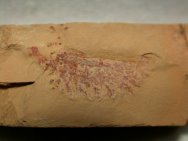Haikoucaris
ercaiensis
Phylum Arthropoda,
Subphylum Chelicerata (?)
Geologic
Time: Early Cambrian (~525 million years ago)
Size: 22
mm
Fossil
Site: Chengjiang Maotianshan Shales, Quiongzhusi Section, Yu’anshan
Member, Heilinpu Formation, Mafang Village, Haikou County, Kunming, Yunnan
Province, China
|  Description:
This unusual arthropod is known as Haikoucaris ercaiensis. It was
described in 2004 from only THREE examples. The authors posited
it as a very rare member of the Chengjiang Biota. The diversity
of soft-tissue fossils is astonishing: algae, medusiforms, sponges,
priapulids, annelid like worms, echinoderms, arthropods (including
trilobites), hemichordates, chordates, and the first agnathan fish
make up just a small fraction of the total. Numerous problematic
forms are known as well, some of which may have represented failed
attempts at diversity that did not persist to the present day. Description:
This unusual arthropod is known as Haikoucaris ercaiensis. It was
described in 2004 from only THREE examples. The authors posited
it as a very rare member of the Chengjiang Biota. The diversity
of soft-tissue fossils is astonishing: algae, medusiforms, sponges,
priapulids, annelid like worms, echinoderms, arthropods (including
trilobites), hemichordates, chordates, and the first agnathan fish
make up just a small fraction of the total. Numerous problematic
forms are known as well, some of which may have represented failed
attempts at diversity that did not persist to the present day. 
The
taxon is allied with the “great appendage” arthropods,
but had a most unusual claw as preserved in the holotype. The similarity
of these claws to those of the Chelicerata led the authors to hypothesize
that it was ancestral to the Chelicerates, which today encompasses
the spiders, scorpions, mites, ticks, and horseshoe crabs. They
may have used their appendage to attack other arthropods in much
the same way as modern-day mantis shrimp. The slender body shape
and large swimming appendages seem to indicate that swimming was
the major mode of locomotion.
|
|





